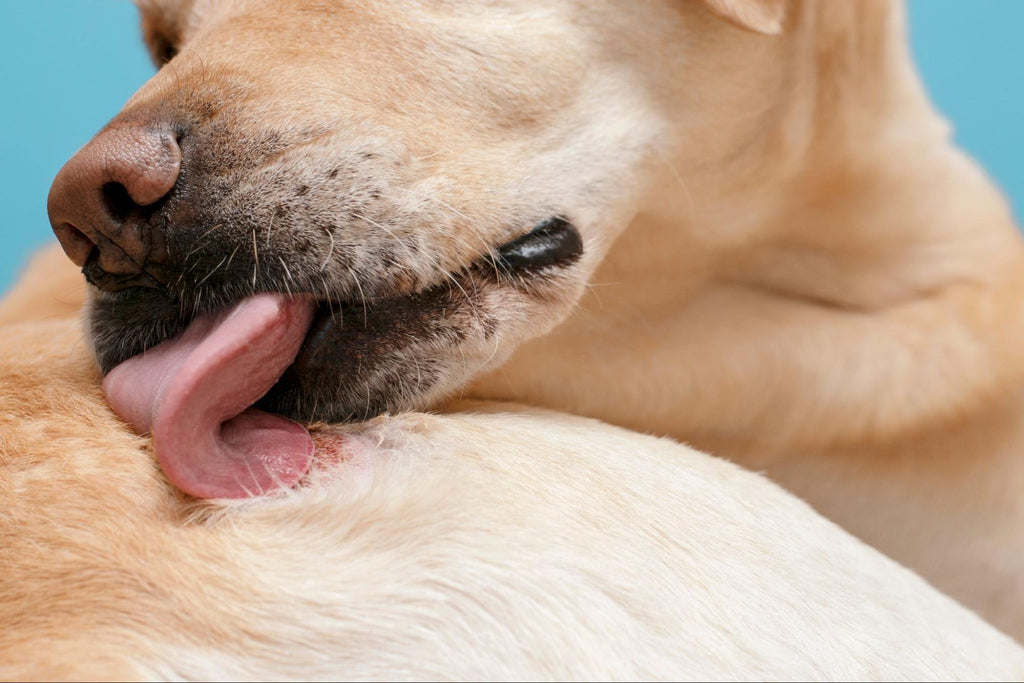8 Min Read
Pentoxifylline For Dogs: Uses, Side Effects & Safety
Key takeaway

Why pet owners are switching to online vet care with Dutch
-
Prescriptions delivered free to you
-
Fast access to Licensed Vets over video
-
Unlimited video visits and follow-ups
Pentoxifylline is a medication widely used in veterinary medicine to treat various health conditions in dogs. From enhancing blood flow to managing inflammatory disorders, pentoxifylline offers veterinarians and pet parents an effective tool for ensuring canine well-being.
In this article, we'll discuss pentoxifylline for dogs, its uses, potential side effects, and safety considerations to provide you with all the information you need to know to make informed decisions about your pet's healthcare.
- What is Pentoxifylline?
- Pentoxifylline for Dogs: Uses
- Dosage & Administration
- Side Effects
- Safety
- Final Notes
What is Pentoxifylline?
Pentoxifylline is a medication used in human and veterinary medicine to improve blood flow and circulation. But what is pentoxifylline for dogs? It's the same medication used for humans, with changes in dosage depending on your dog's needs. This medication is a methylxanthine derivative and is commonly prescribed under the name Trental.1
Pentoxifylline works by decreasing the thickness of blood, which allows it to flow more easily through narrowed blood vessels. This increased blood flow helps to deliver more oxygen to tissues and improves tissue perfusion — the process of blood flow through tissues, particularly in areas with poor circulation.1
In veterinary medicine, pentoxifylline for dogs is often used to manage conditions like certain dermatological disorders.1,2

Pentoxifylline for Dogs: Uses
Pentoxifylline for dogs is often one of the best treatments for canine familial dermatomyositis,1 an inflammatory skin and muscle condition, and has demonstrated efficacy in managing conditions like:
- Atopic dermatitis: This is an inflammatory skin condition characterized by irritated skin, redness, itching, and flakiness.
- Contact dermatitis: This is another inflammatory skin reaction caused by direct contact with an irritant or allergen, resulting in redness and itching.
- Vasculitis: This is a condition caused by inflammation of the blood vessels, which can lead to various symptoms depending on the affected vessels.
- Rabies vaccine reactions: These refer to adverse reactions that may occur after rabies vaccination, ranging from mild local reactions at the injection site to more severe allergic reactions.
- Pinnal thrombovascular necrosis: This condition involves the death of tissue in the blood vessels of the ear flap (pinna) due to inadequate blood supply.
- Ear margin dermatosis: This refers to skin disorders affecting the edges of the ears, which can manifest as inflammation, casting, or even ulceration.1
Additionally, pentoxifylline for dogs has been beneficial in addressing:
- Lupoid onychodystrophy: This is a condition affecting the nails characterized by abnormal nail growth, brittleness, and separation from the nail bed.
- Erythema multiforme: This is a hypersensitivity reaction characterized by the sudden onset of red lesions on the skin.
- Brown recluse spider bites: The bite of a brown recluse spider can lead to tissue damage, necrosis, and potentially systemic symptoms.
- Idiopathic mucinosis of shar-peis: This is a rare condition in shar-pei dogs characterized by the accumulation of abnormal mucin — a type of protein — in the skin, leading to thickened, wrinkled skin.1
Often used concurrently with antibiotics, pentoxifylline aids in treating deep pyoderma, pododermatitis, and lick granulomas by enhancing circulation and antibiotic delivery to affected areas while reducing scarring.1
It has also been investigated for adjunctive therapy for dogs with immune-mediated diseases and dilated cardiomyopathy in Doberman pinschers.1,2
Dosage & Administration
The recommended pentoxifylline dosage for dogs depends on the specific dermatologic condition being treated. For most dermatologic conditions, such as dermatomyositis, ear margin seborrhea, or contact dermatitis, and disease with underlying vasculitis, the typical pentoxifylline dose for dogs ranges from 10 to 25 mg/kg orally every 8 to 12 hours.1,2
For familial canine dermatomyositis, a starting pentoxifylline dose of 25 mg/kg orally every 12 hours is effective. Atopic dermatitis may respond to lower doses of 1 to 15 mg/kg orally every 8 to 12 hours, with a duration of 6 to 8 weeks.2
It's important to note that response to treatment may vary, and adjustments to the dosage may be necessary based on your dog's reaction to the medication.
Pentoxifylline for dogs has a bioavailability of around 50%. The highest levels of the medicine in their blood occur around 1 to 3 hours after they take it. After that, half the pentoxifylline takes about 6 to 7 hours to leave the body.2
Side Effects
Pentoxifylline for dogs can lead to gastrointestinal upset in some dogs, so your vet may ask that you administer it with food. The most commonly reported adverse effects include vomiting and lack of appetite.2
Additionally, this medication has the potential to cause central nervous system (CNS) excitation or nervousness, particularly in animals with pre-existing seizure disorders.1
Both CNS and gastrointestinal pentoxifylline side effects depend on the pentoxifylline dose given and can be minimized by reducing the dosage.1
Rarely, erythema multiforme may occur as a secondary effect of pentoxifylline for dogs.2
If your dog experiences any side effects while taking pentoxifylline, notify your veterinarian immediately. While most pentoxifylline side effects for dogs are mild and manageable, your vet may want to adjust the dosage or recommend additional measures to alleviate discomfort.
Remember, your vet is the best resource for guidance and support when managing your dog's health and any potential side effects of medications. Open communication and regular monitoring of your dog's response to treatment is key to ensuring a positive outcome and maintaining your pet's overall health and happiness.
Safety
While pentoxifylline for dogs is a common medication used in veterinary medicine, it's not without its precautions and potential side effects. Understanding its safety profile is essential for ensuring your pet's well-being when they receive this medication.
First and foremost, pentoxifylline should be approached with caution in animals with specific medical conditions. It's contraindicated in those with coagulopathies and cerebral or retinal hemorrhage and should be used cautiously in those with liver or kidney impairment.1
Additionally, it should be avoided in pregnant animals due to its potential teratogenic effects — the ability to cause abnormalities or birth defects in a developing fetus — and in nursing pets because it and its metabolites are excreted in maternal milk, as seen in rats.1,2
Pentoxifylline can also interact with various drugs, which can affect its efficacy and safety. For instance, concurrent use with fluoroquinolones or cimetidine may increase pentoxifylline blood levels, increasing the risk of side effects.1 Similarly, combining pentoxifylline for dogs with anticoagulants like warfarin may elevate the risk of bleeding.2
When your pet is taking pentoxifylline, some medications like aspirin or clopidogrel, which prevent blood clotting, can increase the risk of bleeding. There's also some debate about using pentoxifylline alongside NSAIDs (like ibuprofen for horses). While some say that NSAIDs might cancel out the benefits of pentoxifylline, one study found that combining a specific NSAID called flunixin with pentoxifylline worked better than using either drug alone, especially for endotoxemia in horses.1
If your pet consumes too much pentoxifylline by accident, they might experience symptoms like flushing, seizures, dizziness, passing out, restlessness, fever, sleepiness, or GI issues. If this happens, take them to the vet immediately. Treatment usually involves clearing the stomach and providing supportive care to help them feel better.1
If you've accidentally given your dog too much of this medication, call your vet immediately for the next steps. Depending on your pet's consumption, your vet may advise you to monitor them closely at home or bring them in for an examination and further treatment. It's crucial to act quickly to ensure the best outcome for your pet's health.
Despite these precautions, pentoxifylline has shown efficacy in managing certain medical conditions in animals. However, before administering this medication, it’s crucial to be aware of your pet’s medical history, potential risk factors, and concurrent medications. Veterinarians must weigh the benefits against the risks and consider alternatives when appropriate.

Final Notes
Pentoxifylline is a valuable medication for dogs, helping with various health issues like skin problems and blood flow disorders. However, pet parents must be aware of its side effects and how to use it safely to keep their furry friends healthy.
It’s important to know when to avoid pentoxifylline, how much to give, and potential adverse effects when combined with other medications. By being informed, pet parents can ensure their dogs get the proper treatment without any unexpected issues.
Worried about your dog's skin? Try Dutch telemedicine for pets to get timely guidance on your pet's health concerns, whether it's a sudden illness, behavior changes, or general wellness advice. With Dutch, you get the convenience of veterinary care in the comfort of your own home.
Additionally, your Dutch membership grants you access to our online pet pharmacy, with prescriptions delivered to your door at no extra cost. You can also compare the cost of pentoxifylline for dogs, and we'll match prices if you find it cheaper anywhere else. We're revolutionizing the way pet parents like you engage with veterinary care. Sign up for Dutch today.
Share
References
-
Drug Profile--Pentoxifylline, dermvetolympia.com/wp-content/uploads/2015/08/dermvetvegas_discourse_pentoxifylline1.pdf.
-
Plumb, Donald C. "Pentoxifylline." Plumb's Veterinary Drug Handbook, Six ed., Blackwell Publishing, pp. 714–715, https://vetrainorg.com/?jet_download=1321.
